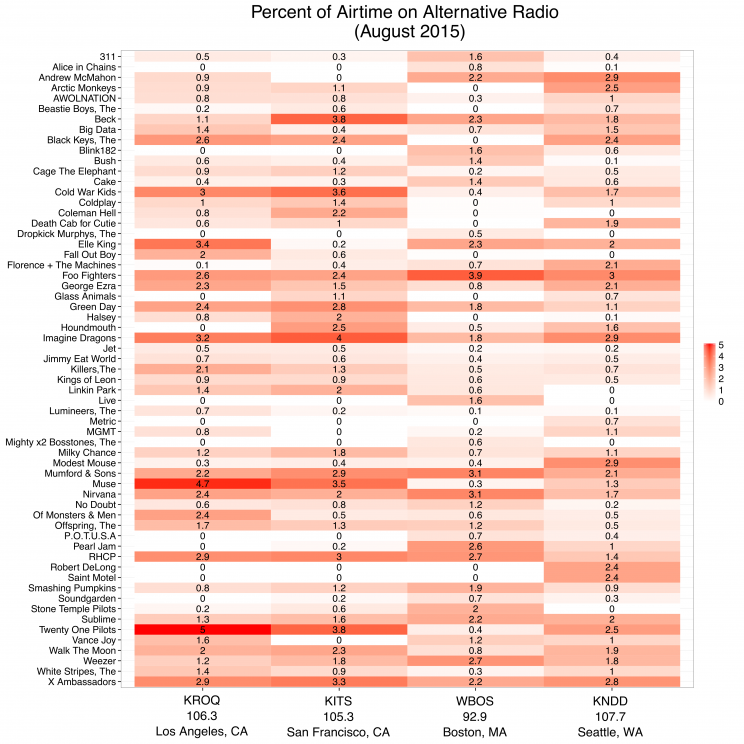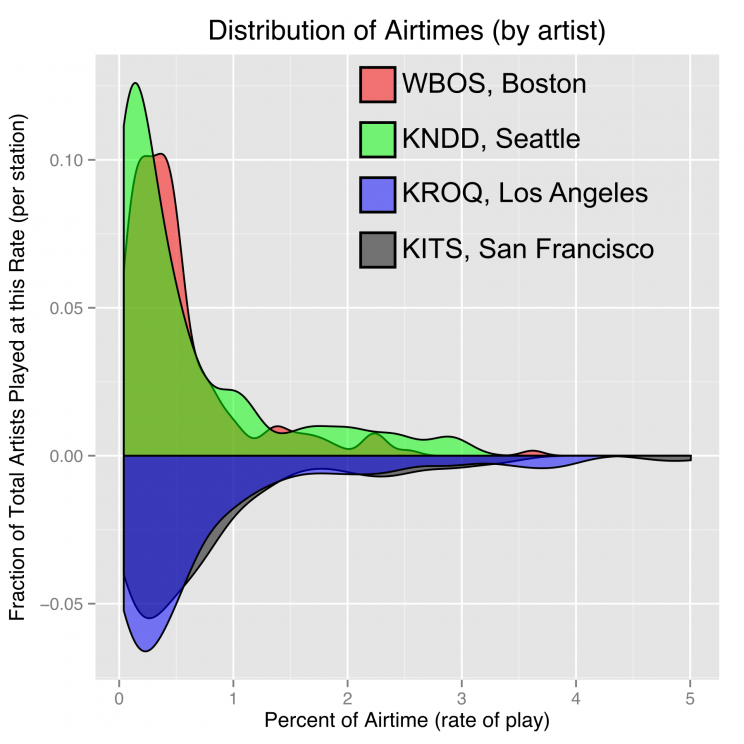Alternative Radio Differences
I credit alternative radio for introducing me to modern music, sometime around early middle school. I’ve since expanded my music listening to many more genres, but I oftentimes still turn to alternative radio if I’m in the car without my own music, both because I still like the general style of music, but also for it’s familiarity.
At one point in mid-August, someone at my place of work complained that the Seattle alternative rock radio station played too much Nirvana because of Seattle’s history with grunge music. I felt rather sure that Nirvana is played similarly on all alternative radio stations, and set about seeing if I could find the data to support my claim. I ended up scraping the data from the August playlists from the alternative radio stations of 4 different cities I’ve lived in: KROQ (Los Angeles) and KITS (San Francisco) were scraped “in whole” based on their archived playlists from August 10 – 30 (albeit, I must be missing songs somewhere based on total number), whereas WBOS (Boston) and KNDD (Seattle) were scraped periodically (their online playlists only show the last 3 hours) over the course of August 15-30. The resulting datasets were ~ 1800 songs each, except for WBOS, which ended up being ~ 2500 songs. While the collection methods / times were not exactly the same, I still believe the sampling should be rather minimally biased.
I (computationally) tallied the number of occurrences of a subset of the artists, which were chosen based on 1) their moderate-to-high rate of play on a given station, 2) my expectation of them to be a “alternative radio staple” (eg. Pearl Jam, Nirvana, Sublime, Live), or 3) to see if they would exhibit locally biased airplay (eg. The Dropkick Murphys).
Some points that come across from a cursory inspection of the data:
- WBOS plays mostly “classic” alternative radio material (eg. Live, 311, Cake, Bush, Alice in Chains, Pearl Jam, Stone Temple Pilots, Soundgarden). There’s also some local bias (eg. Mighty Mighty Bosstones and the Dropkick Murphys).
- KNDD plays a slightly wider range, with a definite bias to local artists (eg. Death Cab for Cutie, Modest Mouse, and Robert DeLong). Interestingly, it actually plays Nirvana LESS often than all of the other radio stations.
- The CBS affiliates KITS and KROQ are a bit in the middle, and are far more similar to each other than either of the others. They love to play certain “hot” artists a lot, like Twenty One Pilots, Muse, X Ambassadors, Imagine Dragons, and Cold War Kids.
- It’s kind of amazing how an artist/song that is super popular on one station can be completely ignored on another. For example, Elle King is currently beloved by all of the stations excepts KITS, where it isn’t played at all. Similarly, Vance joy is also loved on all the stations but KITS. Then again, KROQ apparently doesn’t play any Florence and the Machine.
- I used to dislike KNDD, about a year ago. I personally thought all it played was Sublime, and a handful of currently popular songs, over and over again. After seeing this graph, I think I’ll take KNDD over any of the other alternative radio stations that I’ve lived near, both on it’s general music direction, as well as it’s higher level of diversity.
Artist distributions also shown below. As you can tell, both WBOS and KNDD have more artists played at lower rates. KROQ and KITS have more artists that are played at very high rates.
Data Sources: http://kroq.cbslocal.com/playlist/, http://live105.cbslocal.com/playlist/, http://kndd.tunegenie.com/, http://myradio929.com/stream/WBOSFM/
EDIT: Here’s the data I collected and used; each radio station playlist was given it’s own csv file.
Tools / Methods: Data / web scraping with Python (with BeautifulSoup), data analysis with R (with ggplot2, reshape2), Inkscape for better annotating the final graphs.
Sometime in the far future, I’ll have enough time to clean up the scripts to feel comfortable posting it (without shame).
EDIT: As pointed out by reddit user “veryunlikely”, I replaced the potentially confusing words “band” and “frequency” (with “artist” and “rate”) for precision and consistency of language.

